The Future Of Brain-Computer Interfaces Emerges At Mount Sinai
A Recap of the 2024 New York BCI Symposium
Last week I had the privilege to attend the inaugural New York BCI Symposium, a one-of-a-kind gathering that validated the astonishing popular appeal of BCI by spotlighting the field’s future opportunities and present-day limitations.
The heady lineup featured over thirty experts including researchers, neurosurgeons, founders, advocates, and federal leaders, drawing a packed house of attendees spanning students, clinicians, investors and executives from around the world. Aligned in our common curiosity and interests, we mingled and traded perspectives on all things BCI.
The two-day event was co-hosted by Mount Sinai BioDesign and the Department of Neurosurgery at the Icahn School of Medicine at the New York Academy of Medicine. Presentations spanned key discussions in breakthrough methods, commercial strategy, ethics, and research initiatives. Speakers represented numerous programs from Mount Sinai’s network of interdisciplinary departments for brain health, suggesting that the world’s leading neurotech innovation ecosystem might be developing at New York City’s biggest hospital system.
But the hosts transcended an empire state of mind, inviting experts from competing New York hospitals, and brain trusts from Boston, Pittsburgh, Baltimore, London, and the Netherlands. Such cross-pollination has been essential to the BCI field thus far, and serves as a testament to the collegial leadership of Dr. Joshua Bederson. As the system chair of neurosurgery and executive director of the biodesign program at Mount Sinai, Bederson’s earnest emceeing centered humility over hype and set the tone for two days of collaborative learning and discussion.
The two BCI sponsors of the event, Synchron and Precision Neuroscience, offered dual visions of what an “interface” can be across numerous sessions. Synchron’s strategy bets on speed over size. Their minimally invasive Stentrode, whose endovascular insertion time is down to just 20 minutes, reliably translates signals into digital motor outputs to navigate a growing ecosystem of applications. Despite a relatively modest 16-channel array, Synchron’s focus on pragmatism and execution has garnered valuable respect and mindshare among neurosurgeons, federal officials, and the investor community.
As an earlier stage company, Precision has chosen to optimize for the future over the immediate-term. Their “Layer 7” thin film array has 1024 electrodes in a flexible device that conforms to the cortex. While it has only been used in exploratory studies thus far, implantations will occur via a <1mm incision; once made the “micro-electrocorticography” array (micro-ECoG) will take about 20 seconds to place. The ability to record and stimulate at a field-leading volume will take longer to arrive in market, but likely offer greater options to build value for users when it does.
Here are my top five sessions (actually, seven) focused on the most critical characters in the evolving narrative about BCI’s future: Brain health experts who founded companies to translate research and transform practice, and the early group of end users who’ve had actual skin in the game, known and celebrated as BCI Pioneers.
The Evolution & Future of Invasive BCI
Doug Weber, co-director at the NeuroMechatronics Laboratory at Carnegie Mellon University set the stage. His “why, what, how” history of major BCI milestones unfolded through six Pioneers’ stories, starting in 1996 with Marjorie Hirschberg, and continuing with with Phil Kennedy, Matt Nagle, Jan Scheurmann and Ian Burkhart, before stopping in 2015 with Nathan Copeland, who remains the world’s longest actively implanted (and most artistically prolific) user.
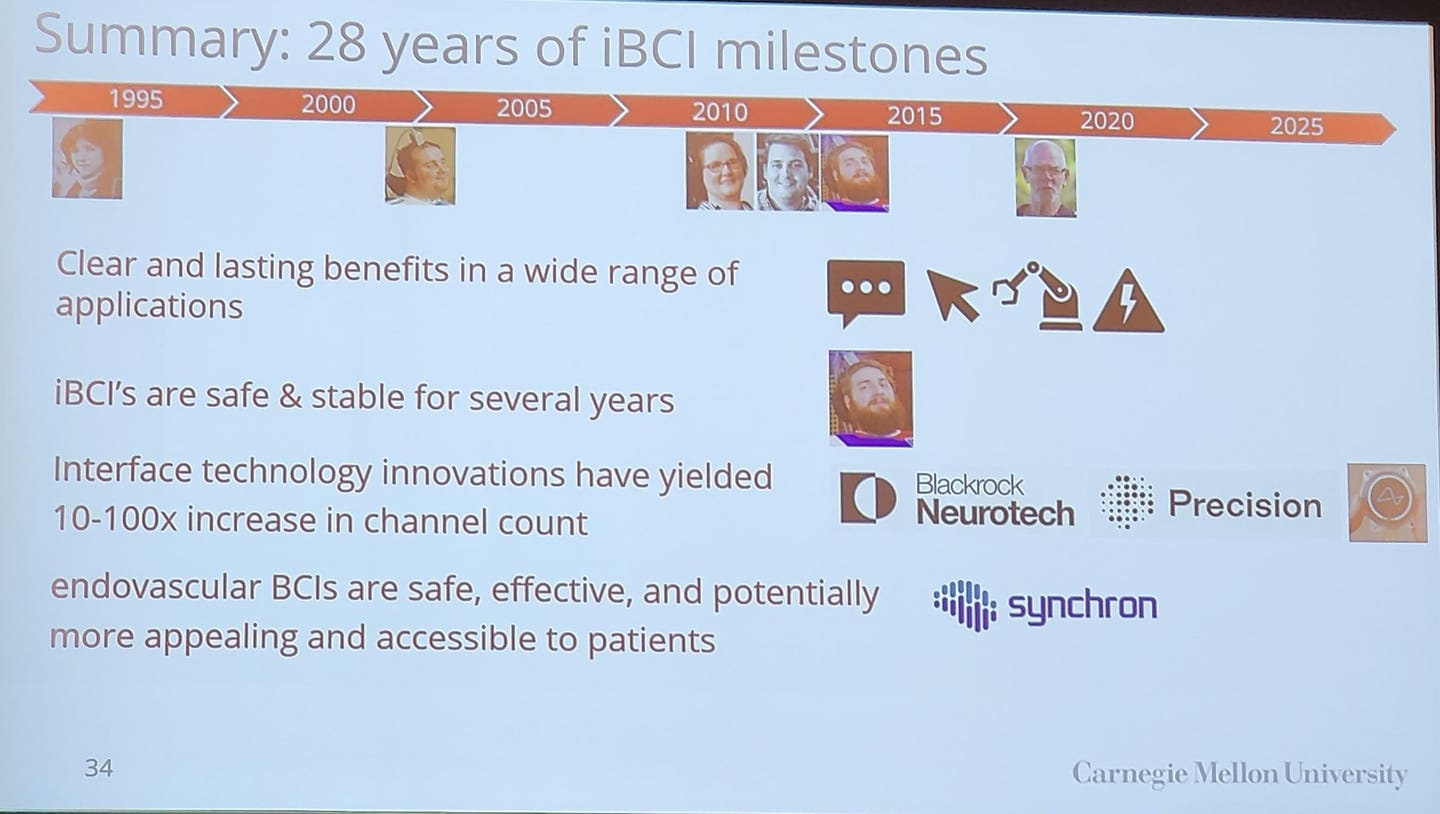
Weber also leveraged his broad industry experience as co-founder and CTO of Reach Neuro and advisor to numerous neurotech startups to frame two major challenges: First is accurately defining the market, which will involve validating and benchmarking outcomes against current alternatives for end users. Second is the umbrella of ethical, legal, social implications (ELSI) posed by real world adoption. This spans a diverse, cross-functional, and challenging mix of topics including data and device security, user agency, accessibility, equitability, policy reforms and more.
While digital device control, a primarily “read” use case, remains the first focal area for most commercial BCI, efficacy trials are still needed “to understand where specific benefits are, and how uniform they are across a population,” which payers will require for reimbursement considerations. Weber also spoke to movement disorders, mental illness, and stroke recovery as expansion markets that could combine BCI with neuromodulation (“write.”) Across subsequent tracks, it became evident that the post-research, read-and-write future of BCI is not that far away.
Unlocking Plasticity & Historical Perspectives in the BCI Revolution
Chad Bouton, a professor and VP of Advanced Engineering at Northwell Health’s Feinstein Institutes, presented a case study on “neural bypass.” This procedure pairs spinal cord stimulation and BCI to produce cortical mirroring around the site of injury. By exciting or “priming” the spinal cord, this approach can create enough neural plasticity to restore limited sensations, and enhance physical therapy and rehabilitation to improve strength and motor control for people who have lost independence through injury.
Today, this remains a research effort requiring highly personalized surgical interventions and rehabilitation, rather than any off-the-shelf options. In response to a question about where neural bypasses will be in five years, Bouton emphasized his lab’s research focus to “promote plasticity any way we can” and the need for a commercial ecosystem of wearable stimulation with onboard AI that can pair with BCI systems and work from users’ homes.
The subject of Bouton’s case study, Keith Thomas, who became paralyzed from the chest down after a diving accident, was in the room with his sister to receive a rousing round of applause. In a brief chat with Bouton, Thomas and his sister after the session, I was moved by the trio’s banter and the depth of their connection, and grateful for the siblings’ candid input when asked how BCI could better serve users and caregivers today. I’ll explore this critical topic in future articles.
Modern BCI in Neurological Recovery
David Putrino, PhD, a professor at Mount Sinai’s Icahn School of Medicine, opened this session with an overview of his lab’s approach to “rehabilitation and human performance.” This involves partnering with patients to adopt and adapt various neurotechnologies as part of active treatment, as well as working with regulatory agencies and payors to promote patient access outside of research settings.
Putrino contrasted the impairment-focused medical model of disability with the social model, which works to remove or mitigate barriers to human performance. In this frame, BCI is arriving at a crossroads moment, wherein innovation is expanding from compensation (e.g. water bottle grippers for people without finger control) to restoration through things like functional electrical stimulation.
He was joined on the stage by Christopher Kellner, MD, an associate professor of Neurosurgery who oversees various programs in care delivery, research, and training in the field of intracerebral care. Kellner’s work entails use of numerous FDA-cleared neurotechnologies, from implanted devices for vagus nerve stimulation, to wearable sleeves paired with a non-invasive brain interface.
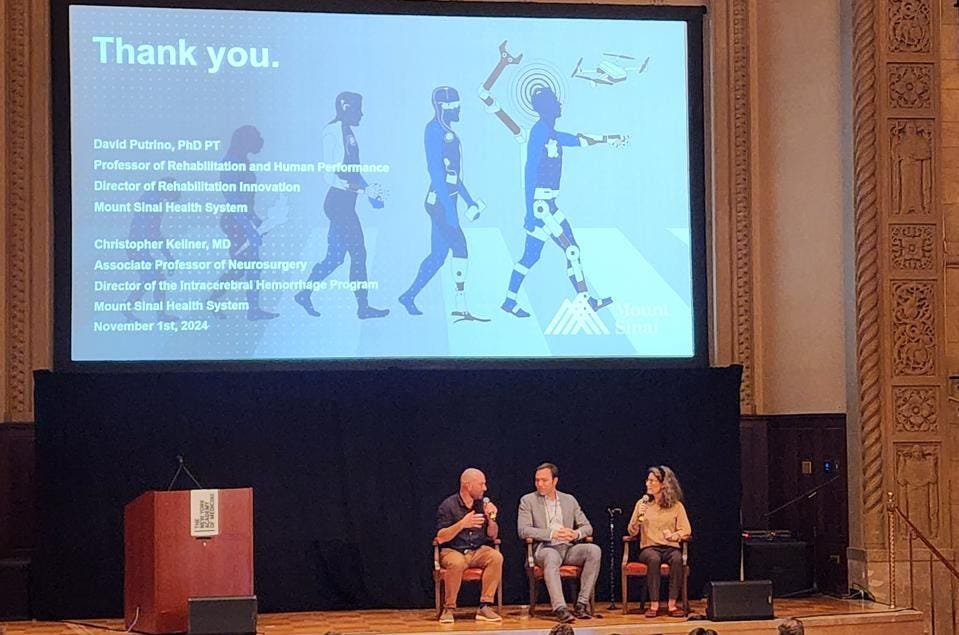
The highlight of the track was hearing from a patient named Katie, who worked with both Kellner and Putrino to regain independence after a devastating stroke in 2019 left her paralyzed down her left side. Only in her early 30’s with a two year old at home, Katie was hospitalized for five months during the Covid-19 pandemic, which involved intensive physical, occupational, and speech therapy, which helped but still left her with limited arm strength at discharge. After two years of haggling with three different insurers, Katie gained access to Medicare which enabled her to join Kellner’s trial for a vagus nerve stimulation implant.
She described the surgery as “not bad,” the six weeks of additional rehab as “you get out what you put in,” and the treatment as “life-changing,” adding that “you can feel your brain rewiring, you can feel the neuroplasticity.” With her young daughter in the audience watching her mom on stage, Katie’s story represents both the possibilities of neurotech-enabled stroke care today, and the fiendish limitations too many Americans face from their health plans. It struck that Mount Sinai’s collaborative, interdisciplinary, tech-savvy, and practically oriented clinical model remains an exception rather than a norm compared to most health systems.
BCI & The Patient Advocacy Point of View
The only thing better than watching videos of BCI Pioneers bending and breaking limits - speaking cybernetically, fistbumping presidents, playing games, making art - is hearing from them directly. Ian Burkhart took the stage numerous times to share his expert perspective as a liaison to the FDA, President of NASIC, philanthropic leader, published researcher, and all around advocate.
In a chat with CNBC’s Ashley Capoot, he shared the story of his spinal cord injury and his clinical trial in 2014 that implanted him with a Blackrock Neuroport array. Seven years of clinical studies included a neural bypass procedure using technology from Battelle that temporarily reanimated his hand well enough to play Guitar Hero. In 2021, Burkhart was “explanted” when the trial’s funding ran out and a scalp infection developed around his implant.
His perspective is that BCI represents an aspiration to deliver improvements over today’s available assistive technologies. When asked about wanting another BCI, he didn’t hesitate to say yes, but demurred that his eligibility remains in question due to prior history, and that now, “the bar is higher for what I would want.” At the top of his list are a fully implanted device to reduce odds of infection, a duration of at least ten years, and in-home functionality rather than limited access in the lab.
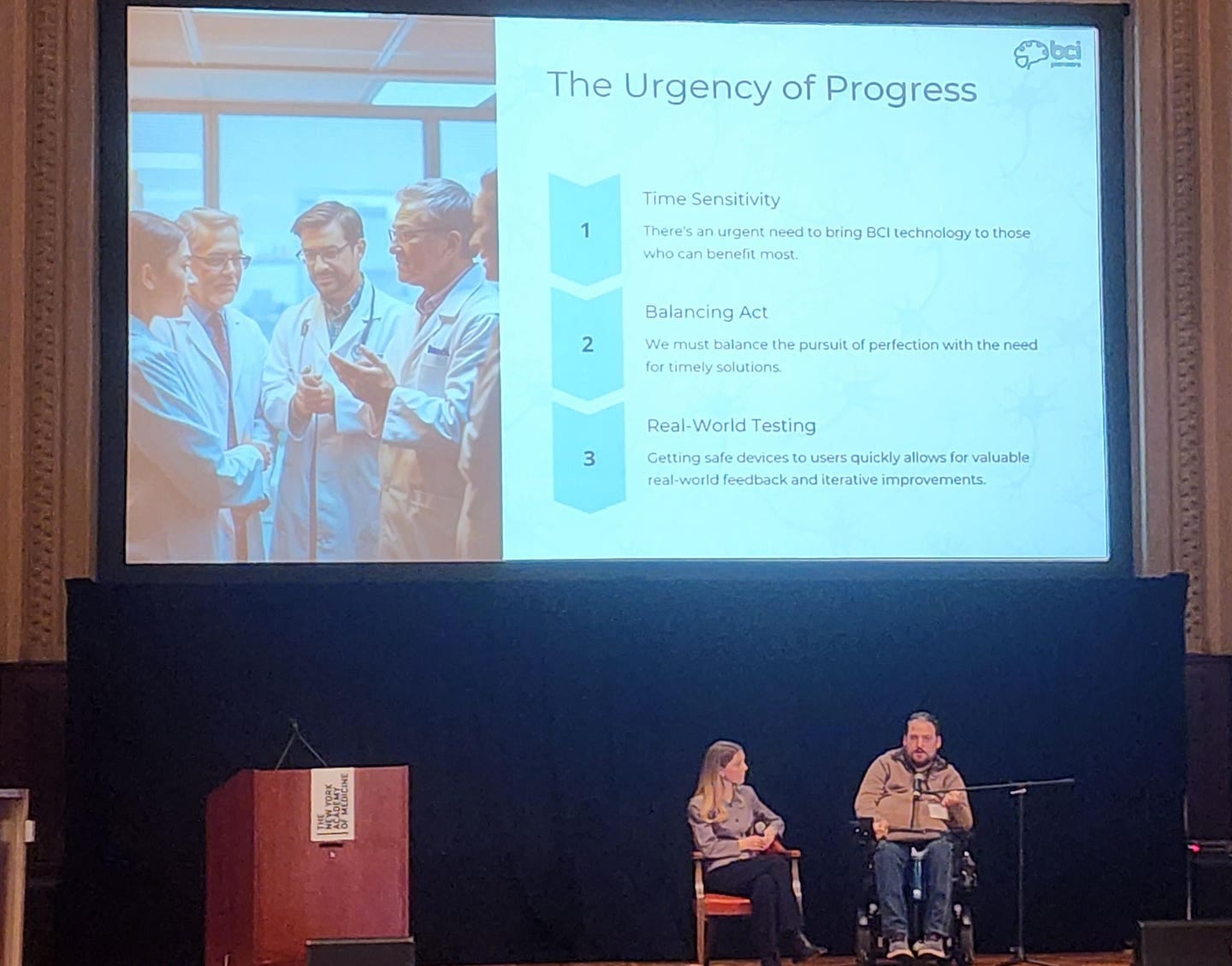
In another session, Burkhart joined Blair Casey, executive director of Team Gleason, and Jennifer French, MBA, for a nuanced discussion on the path forward in BCI. French lives with tetraplegia as a result of a snowboarding accident, and the extent of her neurotechnology advocacy and leadership cannot be understated. Her expertise founding and leading Neurotech Network, NASIC, and the iBCI-CC over the last decade were on display in a masterclass on pre-commercial strategy for the nascent BCI industry, from trust-building and hype mitigation, to functional indication roadmaps for people living with spinal cord injuries, to scaling community engagement for participation in clinical trials.
Selling false hope about complete recovery and restoration via BCI should be avoided by all, and especially by my peers who work in media, marketing, and market research. Key trends for the industry to navigate include shrinking rehab times for spinal cord injury, low clinician awareness and access to new tech, and the need to “jump the chasm” from engaging people enrolled in BCI registries to engaging the broader community of those affected.
Science’s Vision & BCI Startup Spotlight
Max Hodak, founder and CEO of Science Corp, shared their vision restoration pivotal trial, in which a photovoltaic stimulating array implanted at the back of blind patients’ retinas, paired with special eyeglasses, restored the ability to see for the vast majority of the trial’s 38 participants. The implant, acquired in a commercial chess move this spring, is a solar-powered marvel the size of confetti that fits perfectly over Abe Lincoln on a penny’s tail. Through the company’s foundry and a new full stack of BCI tools, Science could bring the cost of in-human BCI development down by a factor of 20. Hodak’s broader vision for BCI is grounded yet groundbreaking.
Hodak was joined on the stage by Precision Neuroscience’s CSO Ben Rapoport, Synchron’s CEO Tom Oxley, Blackrock Neurotech’s CSO Florian Solzbacher, Paradromics’ CSO Vikash Gilja and and Meta’s (formerly co- founder of CTRL-Labs) Patrick Kaifosh. Moderated by Bloomberg Reporter Sarah McBride, the discussion covered a number of emerging industry tensions: standardizing outputs from differentiated systems, collaboration versus competition, demonstrating value to patients versus payors, and prioritizing technical optimization versus real world pragmatism in allocating limited time and money.
Regulatory strategy, payer and clinician engagement, and AI filled a bulk of the Q&A. The diversity of technologies, form factors, invasiveness, user base and other factors limited the depth and generalizability of this conversation, but two key themes emerged: the need to focus on effective productization over technical perfection, and the tailored approach to designing clinical outcomes. The latter will make standardization in this nascent industry a challenge (more on that below.)
In conversation on AI’s role in BCI, participants summarized technical advances in ML for signal processing or deep learning for chip design, as well as generative AI. LLMs can match or mimic the “art of human expression” as part of a product, or speed up the pdf-laden burdens of regulatory compliance, quality assurance, and other mission-critical operational obligations in building a class III medical device company. Based on the brainpower and leadership on this stage, the future of the industry appears in good hands.
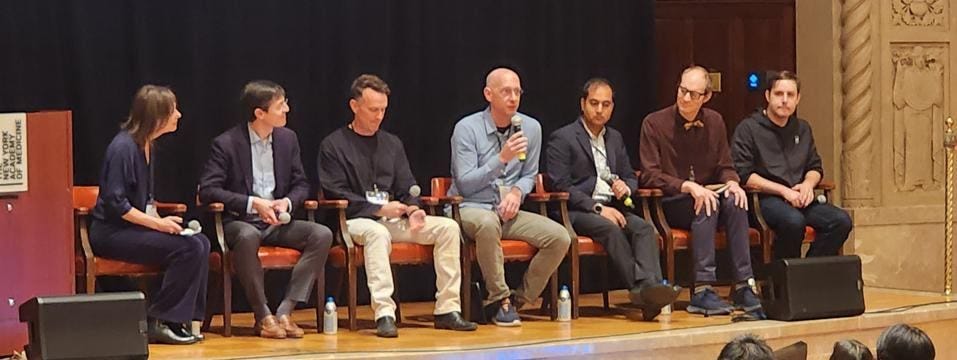
History of the Future: From Research to Revenue
Many if not most of the sessions I attended began by summarizing BCI history, underscoring the robust foundation of knowledge, tools, and practice that clinical researchers have built for the last two decades. But even as scores of brilliant neuroengineers advance technical innovations and test experimental interventions in research settings, the various experts on stage echoed the plain view that industry is the engine that will drive this field forward for the next two decades, for better or for worse.
This set up the billion dollar question: What will the future hold for BCI startups?
According to investors, it’s actually hundreds of billions. Alex Morgan, partner at Khosla Ventures and investor in Synchron and other neurotech startups, framed the opportunity as an unprecedented convergence of historic advances in measurement, materials and other technologies, from AI to AR and much in between. In a later session, Dr. Benjamin Rapoport of Precision Neuroscience referred to this confluent phenomenon as “Moore’s Law for Applied Neuroscience,” with a growth curve mapping electrode channel count over the last 50 years. In Morgan’s words, BCI (and other non-implanted neurotech) “will give us a fine-grained attenuation of the electrical network in the manner we want, when we want.”
Thus, he argued, if the 20th century was the century of the heart, where a similar multi-faceted revolution in cardiology innovation now “creates over $300b in value a year” by augmenting lifespan and healthspan, then the 21st century will belong to the brain. But as we enter the second quarter of the century, the BCI industry today has yet to put any points on the board, in terms of adding economic value to people’s lives.
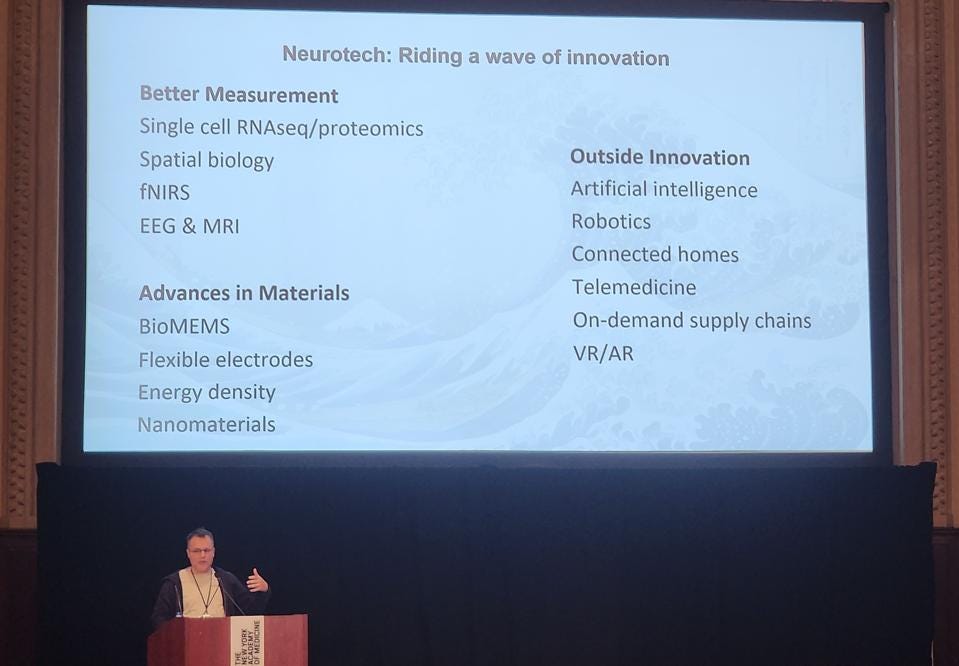
One attendee I met at lunch smirked that BCI appears to be a solution looking for a problem, a view plenty of others share. I’ve personally met or heard from too many BCI Pioneers to agree. His point was well-taken though, that reimbursement is hard, and navigating the market opportunity comes down to a specific (if daunting) set of “known unknowns” that emerged over the two days.
Mind The Gap: Possible versus Probable
A mentor of mine, Dr. Jordan Shlain, cautions against mistaking a clear view for a short distance. Simply put, the road ahead will be hard. Advancing the field of BCI will depend on several factors that emerged over multiple sessions, as well as the new reality of highly unpredictable federal leadership, whose impact over the next four years at FDA, CMS, and other agencies remains to be seen.
Regulatory Science: Work in Progress
As per David McMullen, the FDA’s director of the office of neurological & physical medicine devices, regulatory science at the agency entails “developing new tools, standards, and approaches to assess the safety and performance of the products it regulates.” His new boss, Michele Tarver, has a history of patient-centered public-private partnerships. McMullen divulged his career-long interest in BCI prior to joining the feds and listed numerous efforts underway to engage BCI stakeholders and, in particular, accelerate market success through TAP (“FDA Breakthrough on steroids”), specific funding mechanisms, and aligning COA.
Jen French also identified informing regulatory science as a key goal of the iBCI-CC, describing the group’s work as a “pre-competitive sandbox” to develop technical and clinical standards, user preferences, endpoints economic analysis. These efforts are bolstered by the work of researchers like Abbey Sawyer, a postdoctoral fellow who shared her work in developing digital “activities of daily living” to leverage clinical trials for broader impact.
And yet: Despite the bonhomie, mutual respect, and promising rhetoric, the reality is that alignment will be challenging. In the BCI startup panel, after describing how nuances in product and procedures will drive differences in trial design and clinical outcomes, Tom Oxley summed it up: “Everyone wants to do something slightly different.”
Commercial Strategy & Reimbursement
Persuading payers to cover BCI will undeniably become the field’s top goal. McMullen’s counterpart on the symposium’s closing panel was TJ Sutphin, Ombudsman for Pharma and Tech at the Centers for Medicare and Medicaid. Sutphin also spoke at the aforementioned COA session for BCI last month. His primer covered coding and coverage channels, “innovator’s guide” resources, and touched on coverage decisions for speech generating devices, DBS, cochlear implants, and other topics. Despite the airtime, I felt that he offered little insight to CMS’s specific thinking about BCI.
This is underscores the need to recruit health plan medical directors and commercial reimbursement leaders from Medtronic, Boston Scientific, or other neuromodulation companies to future discussions about BCI. The job of CMS, and to a lesser extent, FDA, is to be reactive to engagement from BCI companies, moreso than act as proactive partners.
Mount Sinai has an opportunity - I would argue, an imperative - to leverage their market relationships as an experienced health system and invite their insurer counterparts into the room in future iterations of this event. This would amount to two-way opportunity for payers to educate attendees on their thought process and perspectives, and absorb key insights on the benefits and value of BCI from some of the world’s leading experts.
Patient-Centeredness & The Missing Caregiver
Patient advocacy will bridge the divide between clinical research and commercial success. Across the two days, Pioneer voices and videos were elevated on the stage in a way that transcended marketing or storytelling; at this early stage, each and every BCI user represents a highly valuable and slightly different case study filled with technical, clinical, practical, and socioeconomic insights that remain largely underleveraged.
Rather than asking Pioneers like Burkhart to repeat their stories, the field needs to lean on their detailed market research, numerous publications, federal advocacy efforts, strategic philanthropy, and other insights. Commercial success will require integrating BCI into smart homes, navigating limits of disability policy and routes to reimplantation, and improving ethics of clinical trials. An example of the latter came from Dan Rubin, Assistant Professor of Neurology at Harvard Medical School/Mass General, where BCI trial participants can “reconsent” twice, for up to an additional seven years of using their BCI following the end of their trial.
Caregiver perspectives were infrequently mentioned in the sessions I attended. BCI cannot cure paralysis, so family members and caregivers have a critical role in expanding conversations on decentralizing clinical research, exploring economic evidence generation around time and costs, and configuring BCI for communication and in-home deployment. The latter was explored briefly by Mariska J. Vansteensel from UMC Utrecht Brain Center in a case study about “nocturnal caregiver calling” that drew questions from BCI executives in the audience, suggesting that such key explorations of daily living should not be relegated to academic research.
BCI: The Human In the Loop
Like the titles of many presenters, this recap has become a bit long, so I’ll close with a powerful framing by Peter Yoo, Synchron’s Senior Director of Neuroscience and Algorithms. In designing functional systems in dynamic interplay between hardware, software, and the end user, Yoo spoke about balancing reliability off the shelf, and adaptability to account for individual customization and technical advances: “This isn’t just a simple engineering challenge. When the human is in the loop, it impacts the whole system.”
BCI then, is more than a field of research, a technology product or a commercial market. It’s a platform for optimizing the common boundaries of computers and human beings. The next era will not spin out from technical revolutions in a laboratory, but by helping people in their homes. Like the word BCI itself, it’s easier said than done. For all the students, engineers, doctors, executives, and others working in this field, the future is not just undeniably bright - it’s here.
Originally published in Forbes on November 06, 2024.






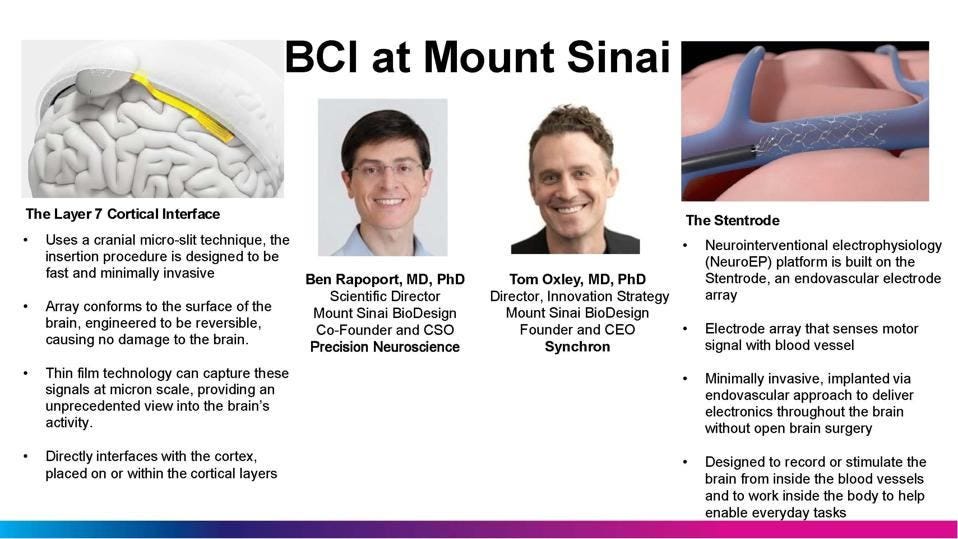
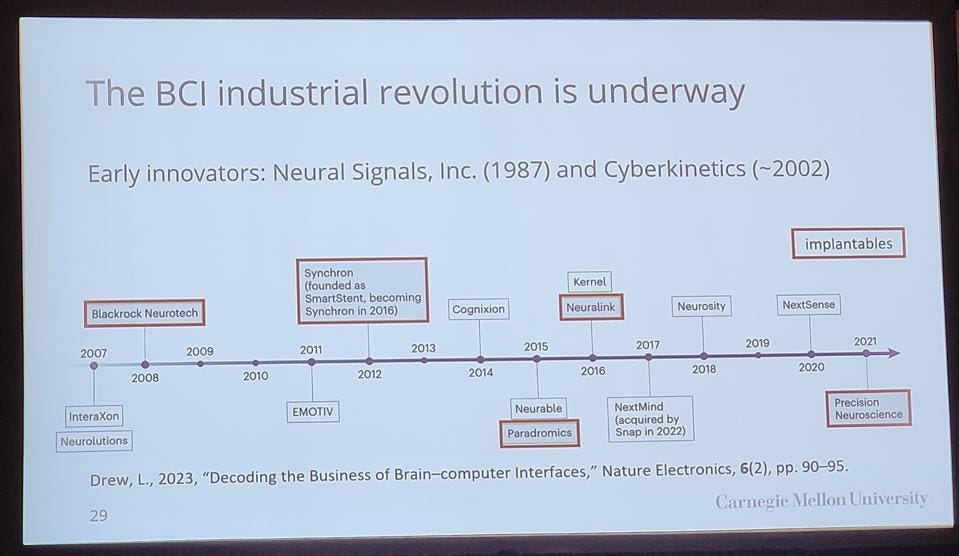
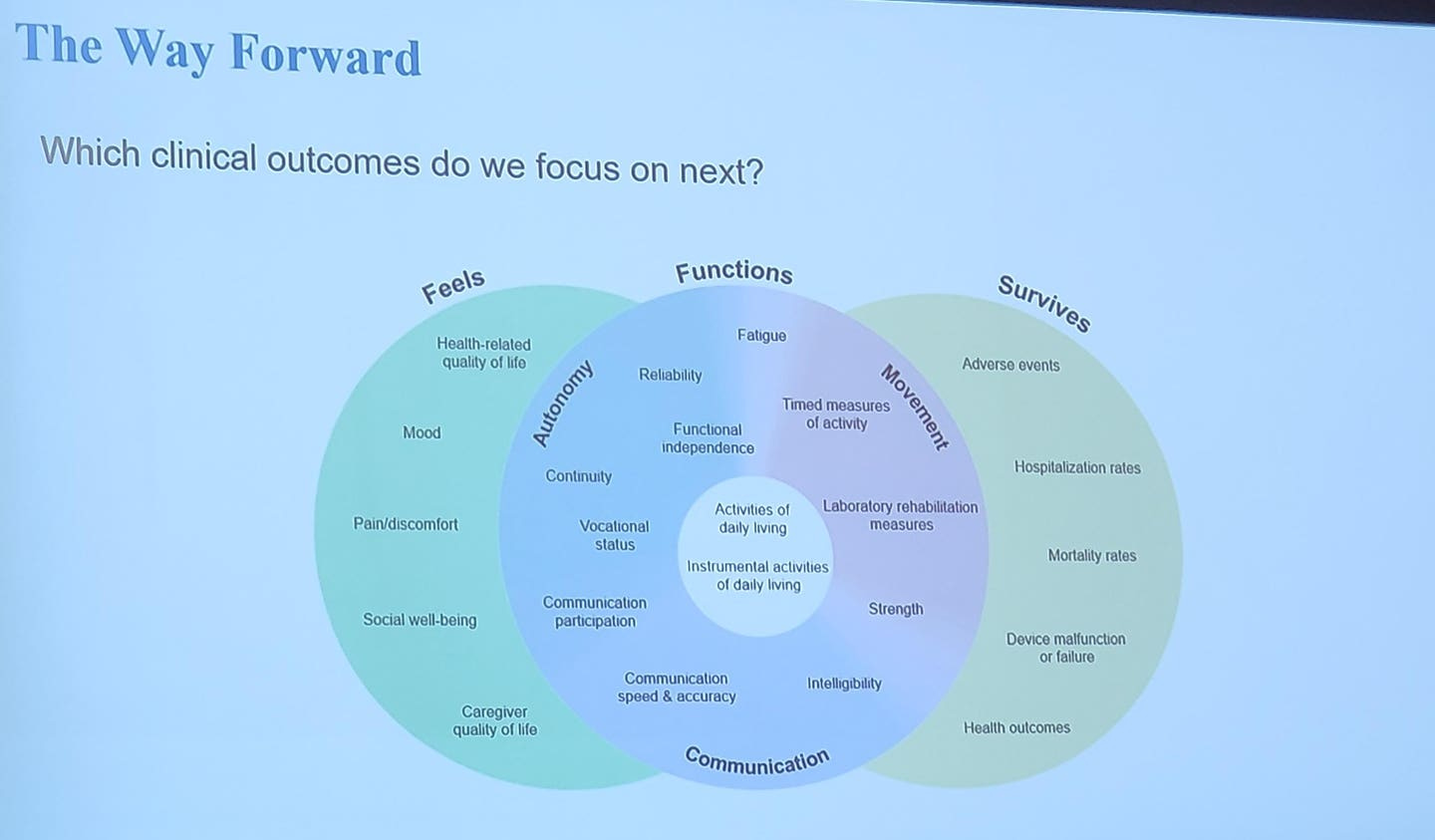
This is all very interesting - thank you for the comprehensive write-up! Was the fourth image's caption mentioning "arm-wrestling insurers" an accidental pun or a forecast of how well patients in future might regain their functional strength and abilities? 😉